Prairie Fare: Inspire Your Menus With Fresh Basil
(Click an image below to view a high-resolution image that can be downloaded)
By Julie Garden-Robinson, Food and Nutrition Specialist
NDSU Extension
I plucked some basil sprigs from our herb garden and I removed the flowering parts.
I knew I should pick leaves fairly often to keep the plant productive. I also knew not to pick the plant bare.
Leave at least one-fourth of the basil leaves and remove the plant’s energy-draining flowers.
As I pruned my prolific plant, the scent of fresh basil on my hands triggered a memory. I participated in a workshop at a culinary institute a few years ago.
“Julie, you are going to make a margherita pizza with pesto sauce,” my chef-teacher said.
“That sounds good,” I said. “Where’s the recipe?” I probably sounded like the novice I was.
“You are creating the recipes,” he replied with a grin.
“OK, where are the measuring cups?” I asked, a bit hopefully. I was getting the idea of where this conversation was heading.
“We have no measuring cups,” he noted.
I should have smuggled some measuring utensils into the class. I had big side pockets on my shirt.
I looked around for hidden cameras. Was I being pranked? Was I going to be “chopped” from the class?
Other chef-teachers were doing demonstrations for their groups. The group members were chopping ingredients.
I bet they had recipes.
I began assembling ingredients for a pizza crust. After the dough was in the proofing cabinet, I began work on the pesto puzzle.
By the way, we had no phones to access recipes online.
I knew fresh basil and olive oil were in pesto. I had written about preparing basil-containing food, such as caprese salads with fresh tomatoes, mozzarella and basil leaves. I knew how to preserve basil by drying and freezing.
I silently begged my brain to conjure the flavor of pesto. I was thinking that pesto includes garlic, but what else?
Can a doctorate in food science be revoked? I felt mine flying out the door of the huge kitchen.
The chef looked over at me as I stood thinking.
“You’ll find Parmesan cheese and pine nuts over there,” he noted.
I found a cheese grater. At least they had one.
I took a wild guess at the ingredient amounts, using my washed hands to grab a bunch of this and a pinch of that. I wasn’t sold on the food safety aspects of this experience.
I found the food processor. It didn’t work.
“You have to jiggle the switch,” the chef said.
I partially baked the pizza crust for a few minutes before spreading the homemade pesto, fresh mozzarella cheese slices and thin slices of ripe tomato. I sprinkled my margherita pizza with some dried Italian herbs.
By some miracle, I came up with an edible pizza. It didn’t look half bad, either.
Basil, or sweet basil, gets its name from its Latin name, “ocimum basilicum,” and its history dates back thousands of years. We can grow basil indoors or outdoors, and it will produce prolific amounts of fragrant leaves with adequate sunlight and water.
Herbs add flavor with minor amounts of calories. Basil is used in a variety of cuisines, including Italian recipes, where sweet basil is used.
“Crazy Basil” is my favorite dish in a local Thai restaurant. This spicy dish arrives on a sizzling plate and features a sweet basil’s spicier cousin, Thai basil, along with chicken and hot peppers. This type of basil withstands high-temperature cooking, compared with sweet basil.
Basil can be used fresh in salads or in cooking. Be sure to add basil at the end of cooking to preserve the delicate flavor. Try infusing ice water with basil and watermelon cubes for an interesting taste sensation.
You also can freeze or dry basil for later use.
To freeze basil, first remove the stems and blanch the leaves in boiling water for three seconds. Then dry the basil with a paper towel and separate leaves to put into a freezer-tight bag.
Or you can freeze basil by pureeing it and putting it into an ice cube tray. Then cover the tray and freeze. Later, pop the frozen basil cubes into a freezer bag and use as needed.
Drying basil is not the best option because the flavor of the herb changes dramatically. If you choose to dry it, separate each leaf with the stems removed. Follow the manufacturer’s instructions for using a food dehydrator. Store cool, dry basil leaves in an airtight container and use within one year.
Try this five-minute recipe and inspire your menu with something new. See https://www.ag.ndsu.edu/fieldtofork for more information about herbs and a variety of vegetables and fruits.
Homemade Pesto
3 c. fresh basil leaves, rinsed and patted dry
4 tsp. minced garlic (or more to taste)
2/3 c. grated Parmesan cheese
1/2 c. olive oil
3 Tbsp. pine nuts
In a food processor or blender, combine all ingredients. Pulse to blend. Try combining pesto with hot pasta for a quick main dish. Spread it on a sandwich or a pizza crust. Blend into a creamy salad dressing for a tasty dip or salad topper, or brush it on bruschetta before baking.
Note: Pesto may oxidize (turn brown), so some people blanch the leaves in boiling water a few seconds and pat dry. Store pesto in an airtight container up to five days in the refrigerator. For longer storage, freeze in freezer containers up to six months.
Makes 16 servings (for sandwich spreads). Each serving has 9 grams (g) fat, 2 g protein, 1 g carbohydrate, 0 g fiber and 75 milligrams sodium.
(Julie Garden-Robinson, Ph.D., R.D., L.R.D., is a North Dakota State University Extension food and nutrition specialist and professor in the Department of Health, Nutrition and Exercise Sciences. Follow her on Twitter @jgardenrobinson)
NDSU Agriculture Communication - July 30, 2020
| Source: | Julie Garden-Robinson, 701-231-7187, julie.garden-robinson@ndsu.edu |
|---|---|
| Editor: | Ellen Crawford, 701-231-5391, ellen.crawford@ndsu.edu |




